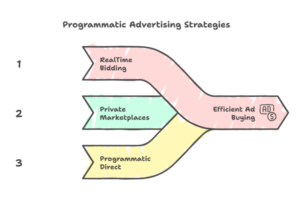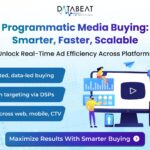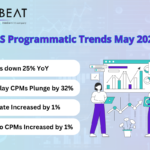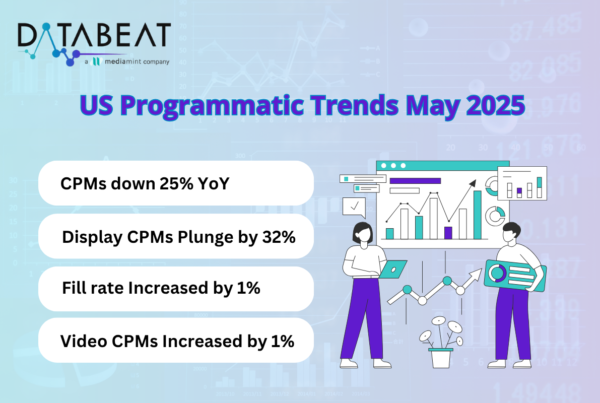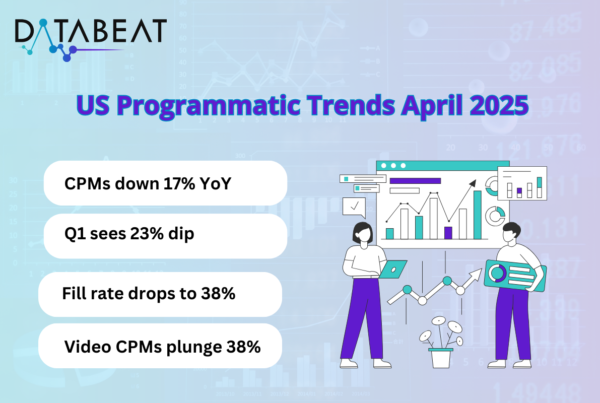
Advertising has changed overnight, and one of the most revolutionary changes in recent years is programmatic media buying. Legacy processes and manual haggling are things of the past in the ad buying industry, courtesy programmatic advertising. It has ushered in a more streamlined and mechanized manner in which brands can buy ad space. This revolution has transformed the way advertisers connect with their customers, with unparalleled accuracy, scalability, and cost-effectiveness.
While marketers are faced with increasingly high expectations of more personalized, relevant advertising, programmatic media buying has been the best answer. Through the application of sophisticated algorithms and immense datasets, it enables advertisers to reach their perfect target audience at the right time, on the right platform, and for the right price.
What is Programmatic Media Buying?
Programmatic advertising in its simplest definition is an automated method of purchasing advertisement space on the web. In contrast to the traditional media buying involving time-consuming negotiations and manual placement of advertisements, programmatic media buying is done through computer programs and algorithms to execute such actions in real-time. It accelerates the purchase of advertisement space, makes it more targeted, and more data-driven.
Programmatic technology provides the advertiser with the power to reach a specific group of people based on several criteria — demographics, interests, behavior, and location — so that the advertisements would reach the people who will act upon them. The system also operates on an auction model, where ad placements are purchased and sold in real-time, providing users greater control over cost and optimisation.
Types of Programmatic Media Buying:
Programmatic buying of media comes under three wide categories: Real Time Bidding (RTB), Private Marketplaces (PMP), and Programmatic Direct. All three have their benefits, thus it is essential that the marketer chooses the most suitable approach based on his requirements as well as budget.
-
Real Time Bidding (RTB)
Real Time Bidding is the most common form of programmatic advertising. When a user accesses a webpage, ad space is available for auction. Advertisers place bids in real time based on how likely they think a user will engage with their ad. The ad goes to the highest bidder, and the transaction occurs in milliseconds.
RTB is an open auction, where anybody can participate in bidding, from large companies to tiny agencies. The auction method makes RTB an economic solution for the majority of advertisers as they will be able to buy high quality placements at affordable costs.
Advantages of RTB:
- Cost Effective: The auction based system of RTB allows advertisers to acquire ad placements at a lower price per thousand impressions (CPM).
- Broad Reach: Since it’s an open auction, advertisers get exposed to a broad universe of inventory on numerous platforms and publishers.
-
Private Marketplaces (PMP)
Private Marketplaces (PMPs) are like RTB auctions, with the difference being that access is invite-only. Publishers cherry-pick a select number of buyers who are allowed to take part in the auction, thus having greater exclusivity and control over whom they allow to advertise on their website.
Publishers of PMPs tend to receive better-quality ad inventory because the publishers screen brands that they want to work with. PMPs blend the programmatic buying automation with the security and control of direct ad sales.
Advantages of PMPs:
- Quality Inventory: Advertisers have access to better-quality ad inventory that may not be available in open auctions.
- More Control: Publishers can exert greater control over who is permitted to bid on their ad inventory, only opening participation to those advertisers who have been deemed trustworthy.
-
Programmatic Direct
Programmatic Direct gives a combination of programmatic automation and programmatic direct buying. When publishers do this kind of buying, they bypass the auction process entirely and sell ad inventory directly to advertisers at a fixed price (usually CPM-based).
This model brings more predictability and eliminates auction uncertainty of bidding wars, allowing advertisers to pre-commit a fixed price for their desired ad inventory.
Advantages of Programmatic Direct:
- Predictable Price: Advertisers are completely aware of the price they would be paying for the inventory, and thus planning and budgeting is easy.
- No Bidding Wars: Since no auction is occurring, no advertisers have to battle at the last minute over bids for advertisement space.
Programmatic Ecosystem: Most Vital Components
In an effort to comprehend programmatic media buying, one will have to grasp the most powerful players and devices behind it all. The programmatic ecosystem consists of a number of different platforms, but each with a particular function to fulfill so that the advertisement reaches the intended audience at the correct time.
-
Sell Side Platform (SSP)
A Sell Side Platform (SSP) is used by publishers to sell and negotiate their ad space. SSPs send ad impressions directly in real-time to potential buyers. SSPs make publishers available to different ad exchanges and demandside platforms or DSPs so that they can earn the most money by selling ad inventory to numerous buyers.
SSP Functionality:
- Inventory Management: SSPs reduce the need for negotiations to be done manually by making ad space management easy.
- Dynamic Pricing: SSPs use information to calculate the ideal price for each ad impression, allowing publishers to maximize available revenue.
-
Demand Side Platform (DSP)
Demand Side Platform (DSP) is where advertisers and agencies purchase ad space. DSPs allow advertisers to bid on inventories in several ad networks and exchanges and automate purchases.
DSPs facilitate highly precise targeting on numerous various metrics such as user behavior, location, and demographics. DSPs also provide the advertiser with real-time insights and data to be used in dynamic optimization of campaigns.
Capabilities of DSP:
- RealTime Bidding: Advertisers place a bid on the ad impression in real time so that they pay an appropriate price as a function of demand.
- Targeted Campaigns: DSP uses the data to enable the advertisers to target the most appropriate users with greater interaction and also the conversion ratio.
-
Ad Exchange
An Ad Exchange is a platform that unites supply (publishers) and demand (advertisers). It is an automated market to sell and purchase ad inventory. Ad exchanges enable both SSPs and DSPs to talk to one another, presenting inventory to the appropriate buyers at the right price.
Ad Exchange Functionality:
- Competitive Bidding: There are several DSPs bidding for inventory, and it enables competitive prices.
- Auction Mechanism: The auction mechanism selects the highest bidder to make the winner, allowing efficient transactions.
Benefits of Programmatic Media Buying
Programmatic media buying has gained some significant benefits over other types of advertisement:
- Efficiency: Advertisement purchase is eliminated through automation, which saves time and limits the scope for error.
- RealTime Insights: Real-time measurement is offered to be used by advertisers for campaign performance and modification in real-time to maximize results.
- Cost Control: With programmatic, advertisers can bid and budget in real-time, so they pay only for decent costs per impression.
- Enhanced Targeting: With demographics, location, and behavior data, programmatic buying of ads is more targeted, and thus higher engagement and conversion rates are the end result.
- Scalability: Programmatic ecosystems are simple to scale, and therefore advertisers can engage with people on numerous platforms — websites, mobile apps, and connected TV.
Conclusion
Programmatic media purchasing has transformed digital marketing by making it scalable, targeted, and efficient. Whether using Real-Time Bidding (RTB), Private Marketplaces (PMP), or Programmatic Direct, the flexibility and automation of programmatic platforms produce improved ROI. As technology advances, the early birds will have an advantage in managing the intricate digital environment and delivering stronger business results.
How can DataBeat Help?
At DataBeat, we help advertisers maximize programmatic media spend with smart optimization and data-driven insights. Whether brand awareness, conversions, or engagement, we help you choose the optimal approaches and KPIs. With offerings like Real-Time Bidding (RTB), Private Marketplaces (PMPs), and Programmatic Direct, we implement the most suitable model to suit your budget and goals. With real-time data, precise targeting, and seamless execution across web, mobile, and CTV, we work to reduce ad waste, drive ROI, and scale efficiently.

